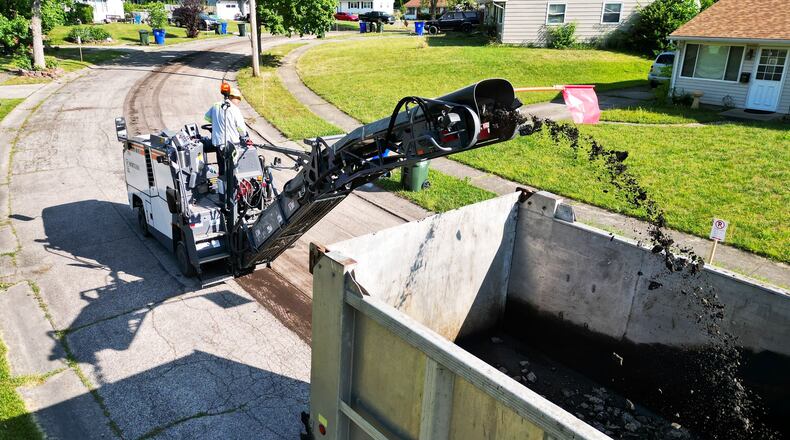That includes the purchase of two machines totaling $565,000 that are helping improve the process.
“We listened to the community. Our community made it very clear that the condition of our streets needed to be improved,” said Porter, adding they heard complaints and requests through 311, Plan Hamilton, streets levy survey, social media and from members of Hamilton City Council.
The city annually has its capital streets repair program, then in March 2020 the street levy passed to inject a little more than $3 million on average into road improvement projects. That still wasn’t enough, Porter said, so they looked to do more.
A pothole blitz was implemented in 2021, where the city filled in 24,000 potholes, but that wasn’t sustainable nor making the impact initially believed.
“We found out that in some areas it’s not just one single pothole,” Porter said. “When you get out there, there were several potholes that needed to be filled. Continuing to fill potholes wasn’t going to be the best solution, so we had to come up with a better solution to improving our work.”
Credit: Nick Graham
Credit: Nick Graham
In 2022, the city started to do milling and paving work in-house to supplement the traditional capital and street levy-funded projects, and that continued in 2023, and Porter said “proved to us that we had the right skill set, the right capability and the right team to do this work, and all we needed were some better tools.”
This past winter, the council approved purchase of the new milling and new paving machines. It allows paving work to be done at least twice as fast, said Public Works Director Dan Arthur.
The city started using the machines and immediately noticed the results with a more efficient miller and a wider and bigger paver. The milling process is twice as fast because the milled asphalt shoots directly into a truck following it, and the paving only requires two passes as opposed to three or four with the smaller machine.
“What we really want to do is to move that needle a little bit, move that barometer,” Arthur said. “We have the capital improvements that you see everywhere, we got roads closed right now. Those were large capital projects where we’re doing the utilities underneath (the road) that are in bad shape, doing the concrete for the curb, and doing the full streets. This is a way where we can attack some of those streets with a lower PCI (Pavement Condition Index) score that aren’t quite on that capital improvements plan but are in rough enough shape that we really need to do something.”
The machines will mill about 2 inches of asphalt and then put down a new black surface until the road can be put on the capital improvement plan.
The machines will be focused on the residential areas, Porter said, streets that are tucked away in remote parts of the community. “But those streets are not forgotten,” he said. “We’re finding ones that are an issue and we’re making those improvements.”
The city puts out updates online annually on its paving projects, including the schedule, how streets are chosen, and the progress of the street levy funds. There had been $4.8 million spent from 2021 to 2023 from the street levy on projects, and there is $3.52 million of those funds for projects either planned or under construction for this year, and more than $5.15 million planned for 2025 street projects.
It’s believed Hamilton may be the only one, or one of the few, communities in the region paving streets as they are.
“It’s an initiative that most places don’t take on,” Arthur said. “It’s a big ask, but it’s so important for us to get to those streets and to make a difference on these roads.”
Porter said it’s just another tool in the toolbox, but Hamilton is not stopping figuring out new ways to improve streets.
“We’re going to continue to evaluate this program, this equipment and come up with new innovative approaches from personnel to equipment to preservation,” he said. “We are laser-focused on improving our streets in our community. Every single day, we’re starting it with (the question), ‘What can we do different today to improve the conditions of our streets tomorrow?”


